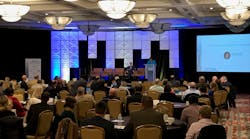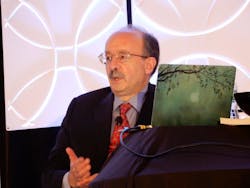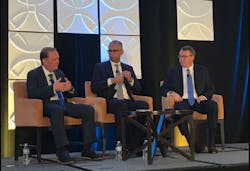As electric utilities embrace - and brace - for the future, one thing is for certain.
They must be honest and open about what the new energy journey is going to bring, according to Colette Honorable, former Federal Energy Regulatory Commission member.
She spoke at the "Empowering Customers and Cities" held in Chicago last week, which as presented by The Energy Times. It brought regulators, utility executives and technology leaders together to discuss survival and prosperity in the rapidly changing energy revolution. Panelists pondered the grid of the future: what its purpose will be and whether it will be necessary, along with disruption of the utility business.
Customer service, microgrids, government, job skills and security were elements threaded throughout the two-day event.
Amory Lovins, co-founder of the Rocky Mountain Institute, named threats to utility business. His “eight Pac-men of the Apocalypse” included business disruptors: integrative design, efficiency, regulatory shifts, storage, distributed renewables, flexible demand, customer preferences and new financial business models.
He also named the “Pac-Men” threatening the grid: super cheap batteries, utility blockchain, lack of reactive power and the resilience imperative.
Amory Lovins // photos by Martin Rosenberg
His wake-up call set the stage for the entire conference, with many speakers referring back to Lovins’ comments and opinions. Regardless, he didn’t end with the threats; he went on to suggest some specific actions that he thought would help society and energy: desubsidization and auto-islanding to name a couple.
“Focusing on the outcome, not motives, can turn gridlock into a unifying solution in energy policy,” Lovins said.
Business Plans
Most of the utility executives agreed their businesses had a lot to figure out as disruptors become more prevalent. “We are always looking at how we will remain relevant, today, tomorrow and in the future,” said Rudy Wynter, president of National Grid. He claimed the driving forces of change in the industry are decarbonization, technology and market development regulatory changes and customers.
“We stopped trying to predict the future,” Wynter said. “We have done some scenarios, looking at a broad array of what the future could look like. Our view of the future is one of more of a hybrid.” Wynter said utilities have a clear role of integrating microgrids and distributed energy resources with the grid.
Terry Boston, former president of PJM, now a presidential appointee on the National Infrastructure Advisory Council, voiced an optimistic view of the business of the grid. He sees energy storage as the silver bullet to get us to a clean energy future, and electrification of transportation as the hope for the CEOs of utilities.
“The grid of the future will be like a roundabout; it will be much more flexible, much more resilient,” Boston said. He ended his presentation with a fitting quote from Peter Drucker: “The best way to predict the future is to create it.”
Customer Focus
Utilities are learning more and more that they must not only ramp up customer service, but also analyze what customers want. Rudy Wynter even went as far to say that “the energy sector is changing because of our customers.”
Wynter said that National Grid has learned that you have to meet the customer where they are “physically and how they want to communicate, finding out what they value and delivering that value.”
Utilities are finding that customers are changing rapidly too. Ben Edgar, business development manager, Microgrids and Distributed Generation, at Black & Veatch, compared the utility-customer relationship to the parent-child relationship.
“As a small kid, you really have no choice where you go, what you do," he said. "But as you grow up, you start to care more about what you’re doing, so there’s a little bit more pushback. Customers are that way today. They used to just say ‘I’ll just buy whatever energy that I use, no questions asked, you send me the bill.’ Now they care about the product,” Edgar said. “Utilities have not had to be customer-focused in the sense that Google or a consumer-focused company would have to be.”
Utilities need to build trust with their customers, according to Edgar. “You can’t move the market forward until you have the customer on your side.”
How much information utilities give customers is a matter of some debate.
Josh Castonguay, vice president of Innovation at Green Mountain Power, said it can be best to keep it simple. “We’re not necessarily as big of believers on sending price signals, especially to the residential market. Time of use rates make sense in some areas like when you have folks that are very intelligent when it comes to energy (such as commercial customers),” Castonguay said. “But when it comes to the residential market, our view is that there’s a lot of complexity in their lives already. We do not necessarily want to add another of layer of ‘By the way, don’t do laundry at this time or don’t charge.’"
However, the tolerance level of customers is changing, said Mike Edmonds, president of S&C Company. “What is acceptable today won’t be acceptable tomorrow.”
The Shedd Aquarium in Chicago is one example of an intelligent energy customer ahead of the curve. Bob Wengel, vice president of facilities at Shedd, shared how the aquarium launched its Master Energy Roadmap about four years ago, which included energy efficiency initiatives, solar rooftop and a 1-megawatt lithium ion battery. Wengel said he wants other energy customers to know that “utilities aren’t your enemy. They are your partner and friend.”
Regulatory Changes
Some suggested that government regulations are holding things back for utilities. Many utilities must justify every move they make to regulators and that can be disheartening. But Rudy Wynter believes regulatory change is accelerating and driving utilities to change. “In the first quarter of 2017, there were 135 proposals, rate case changes or pending changes having to do with utilities.” He cited states that are undergoing grid modernization efforts.
In this and other recent Energy Times conferences, consensus has been that the change happening at the state level is moving the nation forward faster than at the federal level.
“I believe we need to fully leverage the unique ability we have in the United States to innovate differently, state by state, to discern optimal models and solve for local issues,” said Anne Pramaggiore, president of ComEd.
Dominic Thasarathar, strategist at Autodesk, said that technology can help propel regulation forward as well. “Technology can help unlock funding,” he said.
Of course, the government is “designed to make large, fast changes impossible – in any direction,” according to Amory Lovins.
“It’s easy to throw regulators under the bus,” said Michael Quinn, vice president of Strategy at Oncor. But they have an important review role to play when it comes to innovation. They need to make sure it’s the right thing.”





